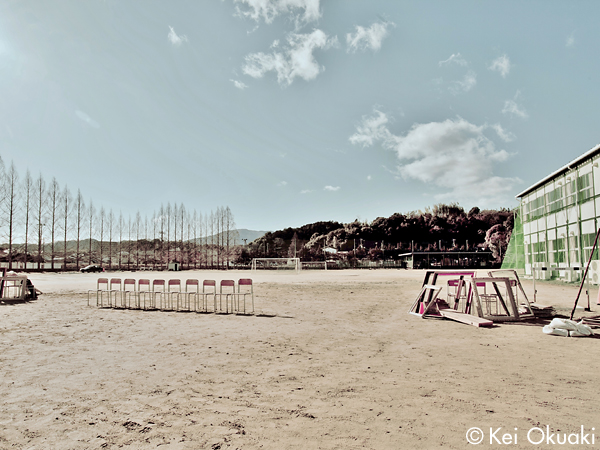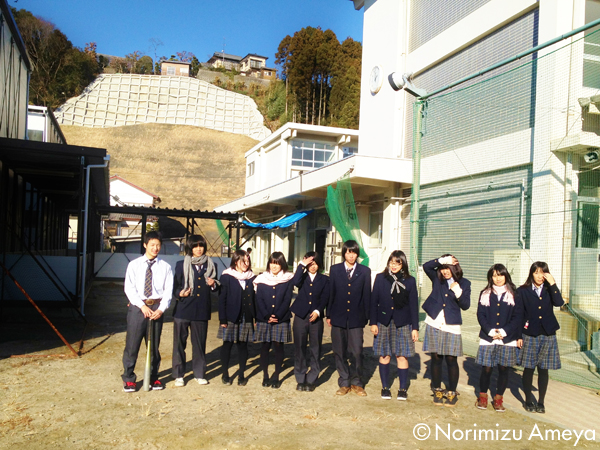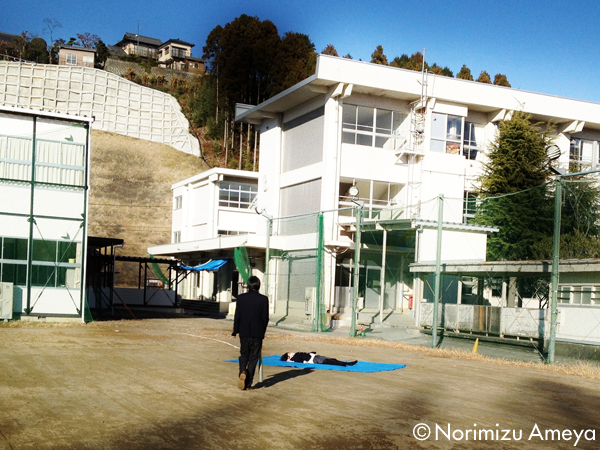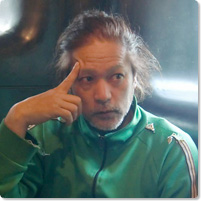
Photo: Kei Okuaki

Photos: Norimizu Ameya

Photos: Norimizu Ameya

Photos: Norimizu Ameya
Data
:
Premiere: 2013
Acts/scenes: 11 scenes
Cast: 10 (3 male, 7 female)
Blue Sheet

Born in 1961. Norimizu Ameya joined one of the major troupes of the Underground Theatre Movement in Japan, Juro Kara’s Jokyo Gekijo in 1978, where he was in charge of the sound. In 1984 he formed the “Tokyo Grand Guignol,” rendering him cult popularity. In 1987, he founded [M.M.M.], a company working intensively on the relationship between mechanical apparatus and the human body. With the “SKIN” series, they established a cyberpunk scenic expression. After 1990 he left the field of theatre and began to engage himself with visual arts – still proceeding to work on his major topic – the human body – taking up themes like blood transfusion, artificial fertilization, infectious diseases, selective breeding, chemical food, and sex discrimination, creating works as a member of the collaboration unit Technocrat. After participating in the Venice Biennale with “Public Semen” in 1995, he suspended his activities as a visual artist. The same year he opened a pet shop in Higashi-Nakano in Tokyo, breeding and selling various animals. In 1997 he published a book, “Do you know how to live with animals?” (the title was later changed to “Do you know how to live with rare animals?,” when it was printed in paperback), where he not only gives information on the distinctions of, and how to breed rare pets, but also reflects on the co-habitation of humans and animals, based on his own experiences. In 2005, he presented a performance in the exhibition “Vanishing Points,” which marked a restart of his activities in visual arts after a long break. This is a work in which he is locked up in a 1.8 meter large white box. With only a minimum of fresh air and a fluid diet he stayed inside the box for 24 days, where knocking on the walls was his sole communication with the outside world. The artist’s presence was the elementary component of the artwork. In 2007 he directed Oriza Hirata ’s Tenkosei (Transfer Student) within the framework of the Shizuoka Performing Arts Center’s (SPAC) “SPAC autumn season 2007,” casting real high school students. The work was also performed at the Festival/Tokyo 09 Spring.
Ameya participated in Festival/Tokyo for four consecutive years with works like 4.48 Psychosis , using foreigners who have emigrated to Japan, and in Romeo Castellucci’s omnibus outdoor theater work Jimen set on a dream island. In 2012, he presented a touring performance named Iriguchi-Dekuchi (text by Mariko Asabuki) based on fieldwork on the Kunisaki Peninsula of Oita Prefecture. In addition to his theater making activities, Ameya also engages in experimental works with contemporary visual artists and musicians. In 2013, he worked with students from the Fukushima Prefectural Iwaki Sogo High School that was struck by the Great East Japan Earthquake and Tsunami to create the play Blue Sheet that won the 58th Kishida Drama Award.

Photo: Kei Okuaki

Photos: Norimizu Ameya

Photos: Norimizu Ameya

Photos: Norimizu Ameya
Data
:
Premiere: 2013
Acts/scenes: 11 scenes
Cast: 10 (3 male, 7 female)
Scene 1: Identifying the living
The students enter. Natsuki begins to check the number of students who are alive and present. Each calls out their number in the line, “One, two, three, … ten, eleven.” The one who calls out the “eleven” that isn’t supposed to be present is Hitchi, in last [10th] position at the back of the line. As the role call is repeated to verify those present again, each one leaves the line in turn to sit in the chairs at the back. Only Reina remains, lying on the ground. Every one stares at her body lying there.
Scene 2: Before that
Hitchi, who found something that looked like a person’s body in a field of grass, begins a monologue. (Natsuki says some words to Momo, who is dozing nearby.) It looked like some kind of living thing (?). But, it also looked like something prior to a living thing (?). With fear and trepidation, Hitchi approaches Reina’s prone body and calls to her. “Are you a human?” She moves and lets out a voice. Startled, Hitchi lurches backward.
With a baseball bat in hand, Shigatatsu slowly approaches Reina. “I think people, can remember, things they have seen. I think they can, forget.”
Scene 3: Embankment
Reina speaks in monologue. After the Great Earthquake, we could see blue sheets all around the town. The embankment of the hill behind the school that collapsed in the earthquake was also covered in blue sheets until this summer. The blue of the blue sheets is the blue of the sky, and of the sea.
Scene 4: Blue sheets
Yuka goes through the actions of daily life as if playing house, on the “house” of blue sheets spread out on the ground. Watching from a distance, the students put Yuka’s actions into words.Yuka begins playing the guitar. “That house, where I lived … Probably, I’ll never, go back there again.” Reina wraps Yuka’s body in a blue sheet.
Fumiya talks about the school buildings. He had only entered the school’s North Building once, when he took the school’s entrance exam. Two days later the earthquake struck. By the time the initially postponed ceremony for new students entering the school was finally held, the North Building had been closed down. Classes were moved to a temporary pre-fab building. They say the North Building will be torn down within the year. In the earthquake, many people, died. But, we … didn’t die.
Scene 5: Birthday
The scene is the everyday classroom. Airi approaches Shigatatsu with a rather strained “Happy birthday.” She says she wants to be his girlfriend. Shigatatsu refuses her, saying, “I don’t know you. So, I don’t like you.” By herself, Airi begins to divine their future. As Shigatatsu points at Airi, he is suddenly revisited by the memory of what he saw in the grass field. The terrible stench of what looked like a lump of flesh ….
Scene 6: Practice for sleeping
Momo is looking at herself in the mirror, and Natsuki is beside her. Momo sleeps all day long, every day. She says she is practicing to be able to sleep endlessly, and without dreaming.
Scene 7: Gray cat
In a corner of the classroom, Yuka begins talking about this and that. There is a kitten born of a white cat and a black cat, and that kitten has black fur. Yuka says she thought the two colors would mix and the kitten would be gray. The conversation shifts from cats to snakes and then to fish. Fish don’t eat the baby fish or eggs that have spawned. Humans, kill other humans, but still they live on. Like the kitten born from the white and black cats, children are a mix of the two essences they receive from their fathers and mothers. That means there are two completely different essences within you. And, that you eventually becomes an adult … and when we become adults, will we be in a position where we will kill someone …?
Scene 8: Reason for sleeping
A conversation goes on between Natsuki and Momo. Momo’s father works in the company where the nuclear power plant accident occurred and Natsuki’s father works for the subcontract company that performs the measurements of radiation released by the nuclear plant. Momo says that it was after the earthquake that she became constantly sleepy. Whenever she tries to think about something, her head grows heavy and she falls asleep. Momo asks Natsuki what the real reason is that human beings sleep.
Scene 9: The sky
Izumi is pressing Hitchi to tell her if the thing she saw in the grass field was a dead body. Hitchi becomes lost in confusion. Was it something prior to a human? But, I can tell you what color it was. It was blue, as if it was reflecting this sky, Hitchi says. The two look up at the sky. (Beside them Momo and Natsuki, and also Reina, who has appeared unnoticed, also look up at the sky.) Yuka is on her cell phone apologizing to someone. “I’m still, too afraid, to mix. I’m sorry … really sorry?”
Scene 10: Weather report
Izumi is giving the others sentences to translate into English – The blue sheet, is blue. Today, the weather is very fine. Tomorrow’s weather, isn’t known.
Scene 11: That time
Natsuki begins leading a game of paper, scissors and stone. The others answer the questions she gives them one after another – Who wants to leave the town of Iwaki after we graduate? Who wants to leave Japan someday? When you were reborn, would you want to be a human again? The next game is musical chairs. When the last two are left circling the last chair, the game suddenly ends.
Shigatatsu and Fumiya are the only ones who stay on. Fumiya is muttering thinks about watching his house being broken down [by the tsunami or by the earthquake] and expressing the process in a dance. After piling up the chairs into what looks like a strange sort of tower, Shigatatsu says to Fumiya: “I think people, can remember, things they have seen. I think people, can forget, things they have seen.”
Fumiya’s voice grows louder. “Run! Get away from here! Run! Run! Run!”
The students come back. The words that each has spoken are repeated in a refrain, and they begin the count of those who are alive and present again. After “ten” someone says “eleven.” After the count is finished, they all leave toward the far side of the school ground. One remains, it is Reina, and she begins to talk about “that time.” … The time she began to think about the world she has departed from.
From the far side of the school ground we hear all the students calling. “He--y! He--y, you! Are you a bird?”
Reina runs to where the others are. ““He--y! He--y, you! Are you all humans?”
Related Tags